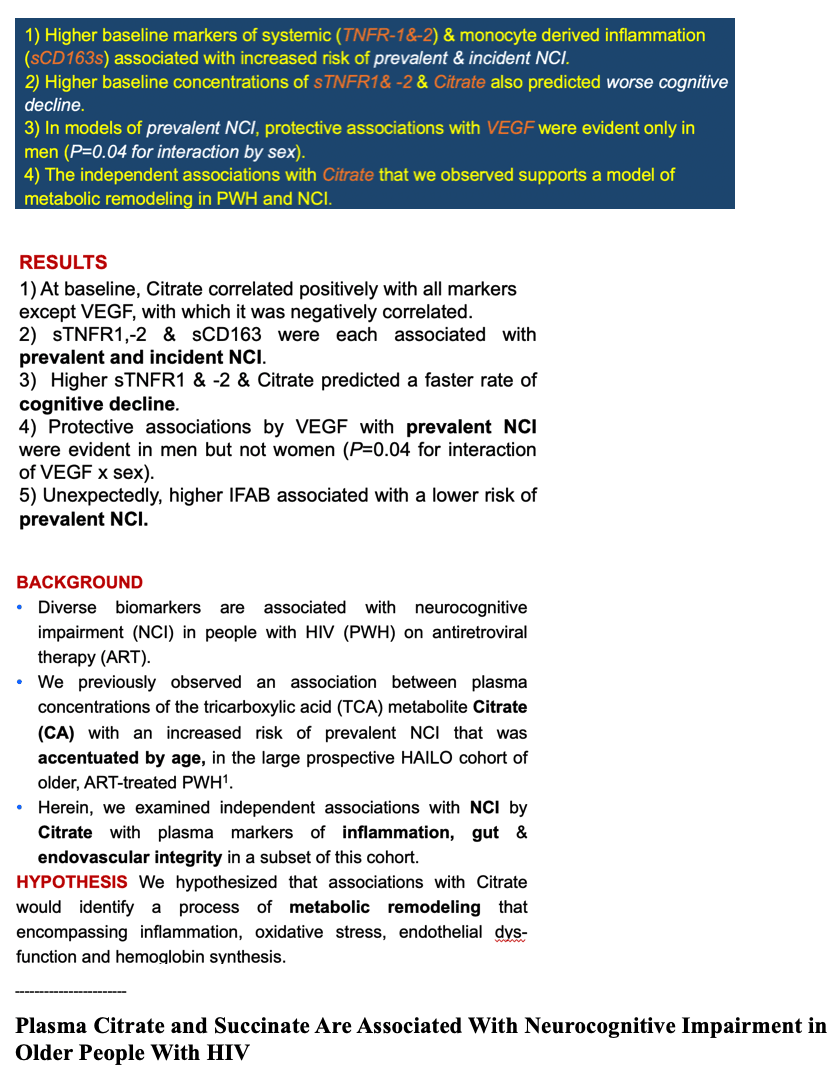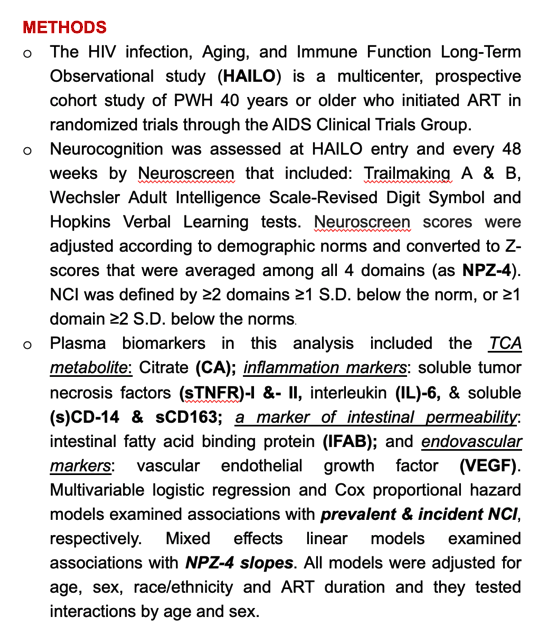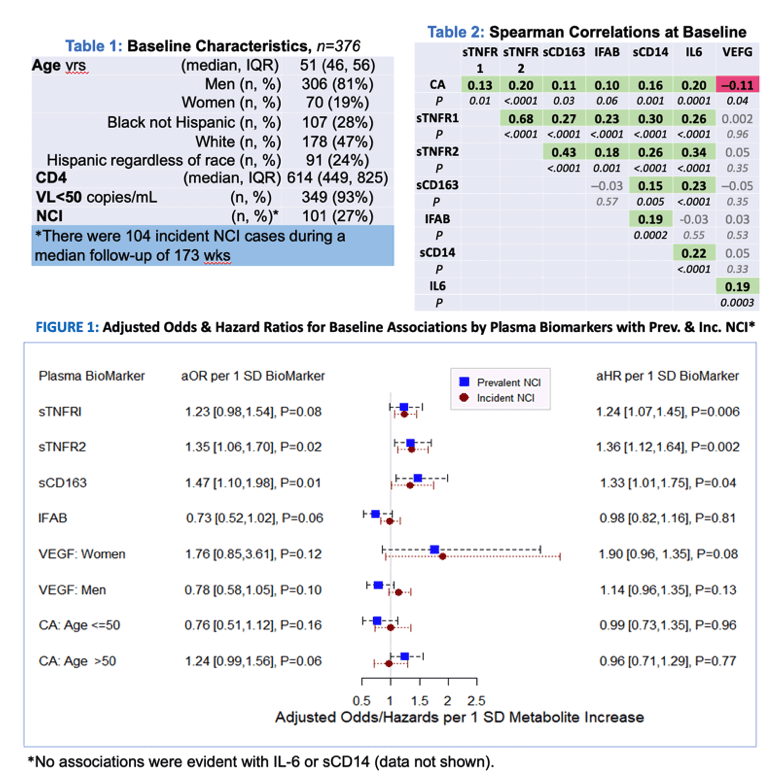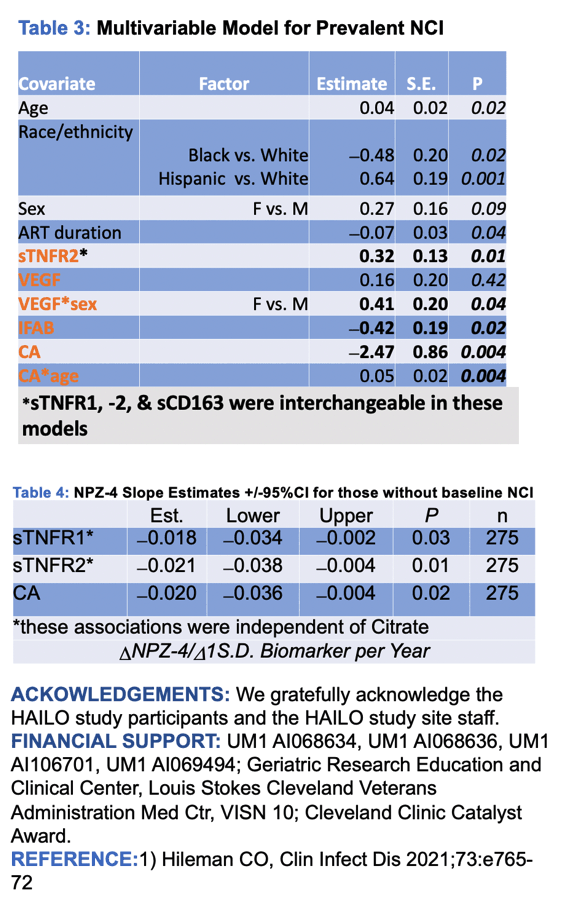 |
 |
 |
| |
Associations Between Plasma Biomarkers and Neurocognition in ART-Treated PWH
|
| |
| |
CROI 2022 Feb 11-16 pdf attached
Robert C Kalayjian1, Corrilynn O Hileman1, Ronald J Ellis2, Asha R Kallianpur3, Roger Bedimo4, Kristine Erlandson5, Susan Koletar6, Babafemi Taiwo7, Kunling Wu8, Frank Pallela7, Katherine Tassiopoulos8
1MetroHealth Med Ctr, Cleveland, OH, 2Univ California San Diego, CA, 3Cleveland Clinic & Cleveland Clinic Lerner College of Medicine of Case Western Reserve University, Cleveland, OH; 4VA North Texas Health Care Center, Dallas, TX 4University of Colorado Anschutz Medical Campus, Aurora, CO 6The Ohio State University, Columbus, OH 7Northwestern University, Chicago, IL 8Harvard TH Chan School of Public Health, Boston, MA, United States for the HIV Infection, Aging, and Immune Function Long-Term Observational study (HAILO) A5322 Study Team

CID August 2021
So, why are high levels of citrate and succinate clinically important, and how might they contribute to the impairments we found? Citrate is the first metabolic intermediate of the TCA cycle and is actively transported to the cytosol by the mitochondrial citrate–malate exchanger, a process that is induced by inflammation [25]. In the Central Nervous System HIV Anti-Retroviral Therapy Effects Research (CHARTER) study, higher CSF concentrations of the TCA cycle metabolite citrate was prognostic, in recursive partitioning models, of worsening neurocognitive status [13]. Additionally, higher CSF citrate concentrations were associated with worse global, executive function, and motor ability domains in cross-sectional analyses [13].
Higher plasma citrate and succinate are associated with worse cross-sectional and longitudinal measures of neurocognitive function and gait speed that are age-dependent, supporting the importance of altered bioenergetic metabolism in the pathogenesis of NCI in older PWH.
Further, these results extend previous studies identifying the importance of increased glycolysis and possibly mitochondrial dysfunction in the pathogenesis of NCI in HIV.
While the reason behind this observation is not clear, it is consistent with findings from the Multicenter AIDS Cohort Study (MACS), a long-term prospective cohort study of HIV infection in men who have sex with men in the United States, which identified lower performance on all 5 neurocognitive domains with older age, with a greater-than-expected effect of age on episodic memory and motor function in individuals with late-stage HIV disease [37]. Perhaps the observed interactions with age result from enhanced vulnerability among older persons to common detrimental metabolic effects on both neurocognitive and physical function in PWH, or there could be a threshold effect due to mitochondrial dysfunction. Interestingly, however, the association between citrate and gait speed suggest that this process may begin earlier in life as slowing gait speed may predict future NCI [14–16].
Neurocognitive impairment (NCI) is common among people with HIV (PWH) despite virally suppressive antiretroviral therapy (ART) [1, 2]. HIV infects perivascular macrophages, microglia, and astrocytes, but not neurons [3, 4]. Associations between NCI and biomarkers of inflammation, including those associated with macrophage activation, support important contributions by ongoing neuroinflammation to this disorder [4–8].
Upon activation by lipopolysaccharide (LPS) and other stimuli, macrophages and microglia substantially increase glycolysis and reduce oxidative phosphorylation, a process similar to that described in cancer cells as the Warburg effect [9, 10]. This metabolic shift results in an accumulation of some tricarboxylic acid (TCA) cycle metabolites, including citrate and succinate. Actively transported from mitochondria to cytosol, these metabolites may directly promote disease by inducing reactive oxygen species (ROS) formation, while also engaging pro-inflammatory pathways [11].
In metabolomic analyses, higher citrate and succinate concentrations in cerebrospinal fluid (CSF) were previously associated with NCI in PWH [12, 13]. Based on these observations, we hypothesized that a metabolic shift akin to the Warburg effect may contribute to NCI in PWH. To test this hypothesis, we explored associations between fasting plasma citrate and succinate concentrations with cross-sectional and longitudinal measures of NCI in the multicenter AIDS Clinical Trials Group (ACTG) A5322 study (the HIV Infection, Aging, and Immune Function Long-Term Observational study; HAILO). Because gait speed closely correlates with neurocognitive function, and slower gait speed may precede cognitive decline [14–16], we also examined associations between these TCA cycle metabolites and gait speed.
--------------------------------



|
| |
|
 |
 |
|
|